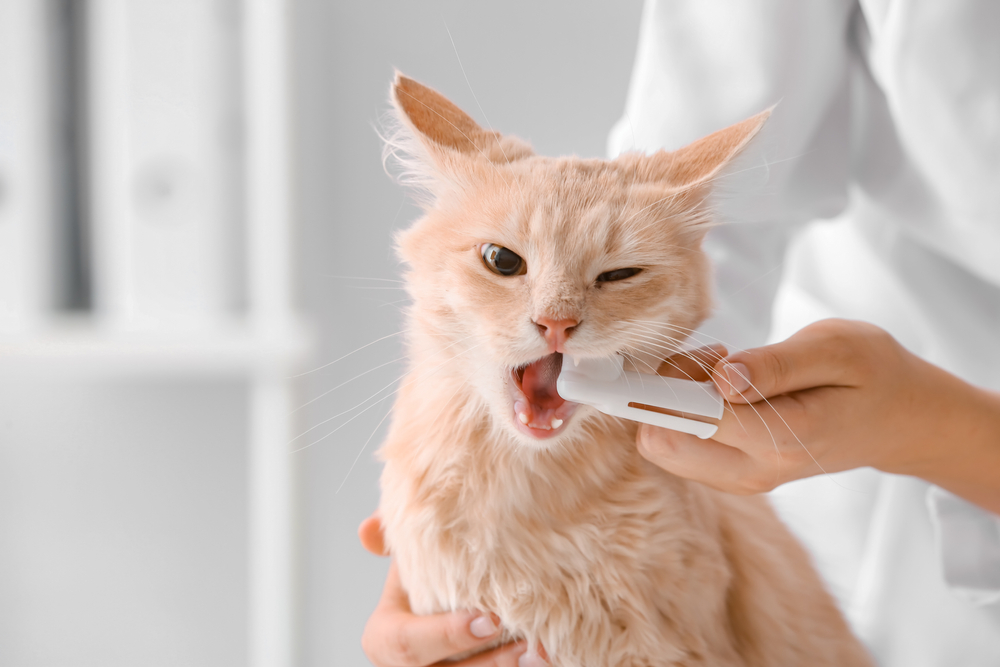How to Properly Care for a Cat’s Teeth
December 31, 2023

Experts suggest that 50% to 90% of cats over four years old have some dental disease. Cats do not usually show symptoms of oral discomfort, and it is easy for the conditions to go unnoticed. If a cat is experiencing dental pain, they avoid eating or move away when you try to touch their face. If oral issues go untreated, it can lead to serious health issues, including infections, malnutrition, drastic weight loss, and more.
Brushing Your Cat’s Teeth
Brush your cat’s teeth two or three times a week. The best time to start brushing your cat’s teeth is while they are still young. However, if you have an older cat, you can still teach them to accept teeth brushing. Choose a quiet time and place and begin by gently touching their teeth.
Getting them accustomed to having their mouth touched will make it easier for them to accept the process. Use a moist gauze and your finger to clean your pet’s teeth before introducing a toothbrush. Your vet can recommend feline-friendly toothpaste and toothbrushes for your cat.
Using Pet-Safe Oral Products
You can use pet-friendly oral products to complement the brushing. The products are helpful if your cat resists brushing. Oral rinses and water additives can help to reduce plaque and keep your pet’s breath fresh. Oral rinses contain chlorhexidine, an antibacterial agent that removes plaque from tooth surfaces and oral tissues.
Water additives contain zinc, benzoate, and chlorophyll. You add the additives to the pet’s water bowl. They help to kill bacteria in the mouth, preventing the buildup of plaque and tartar and keeping the breath fresh.
Dental Treats and Chew Toys
Cats do not chew toys as frequently as dogs, but you can get dental toys for your pet’s health. Most chew toys in the market are designed for dogs, but you can get some specifically designed for cats. Mesh or rubber chew toys gently clean the teeth and massage the gums.
Choose the right size toy to avoid a choking hazard. Dental treats usually have a crunchy texture and contain ingredients that help to reduce tartar and keep the breath fresh. Dental treats and chew toys are not a replacement for brushing but can complement oral care.
Choosing Dental-Healthy Diets
Talk to your veterinarian about the best diet for your cat’s overall and dental health. Studies show that cats that eat mostly kibble, or dry food, instead of wet foods have less tartar. They are less likely to develop gingivitis and other dental issues.
However, if your cat already has dental issues, they may find it hard to chew dry kibble. Dry foods usually contain more carbohydrates than wet foods, which can lead to weight problems. Your vet can recommend the best prescription diet to improve your cat’s dental health.
Schedule Regular Dental Cleaning
Schedule regular dental checkups and cleanings for your cat. A veterinary dentist will help to keep your pet’s teeth clean and healthy. The frequency of professional cleaning may differ from one cat to the next, but vets usually recommend annual checkups.
The dental visit will usually include an exam before placing the cat under anesthesia. Using special equipment, the vet cleans the teeth — above and below the gumline — before polishing and scaling them. Keeping your cat’s teeth clean and healthy is vital for their health.
For more on how to properly care for a cat’s teeth, visit Lone Oak Animal Clinic at our office in Paducah, Kentucky. Call (270) 554-0385 to book an appointment today.


